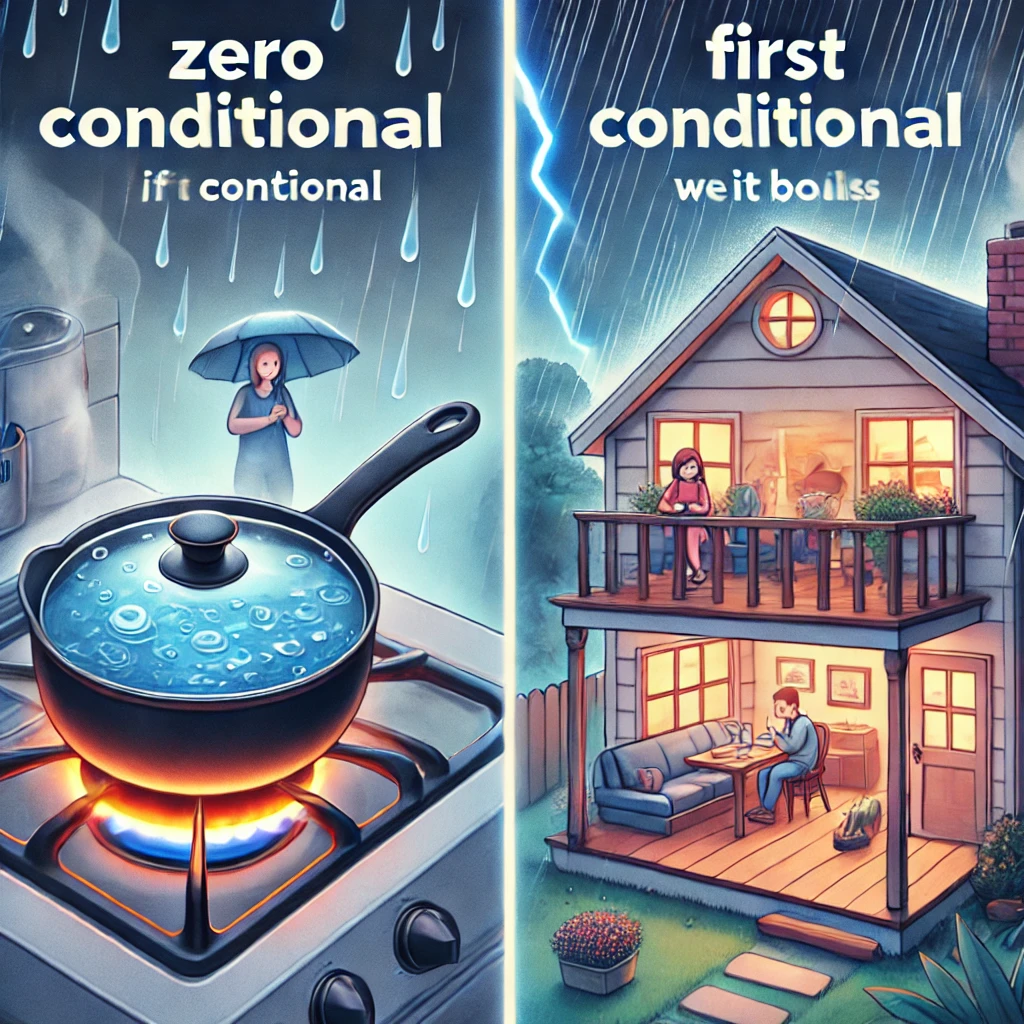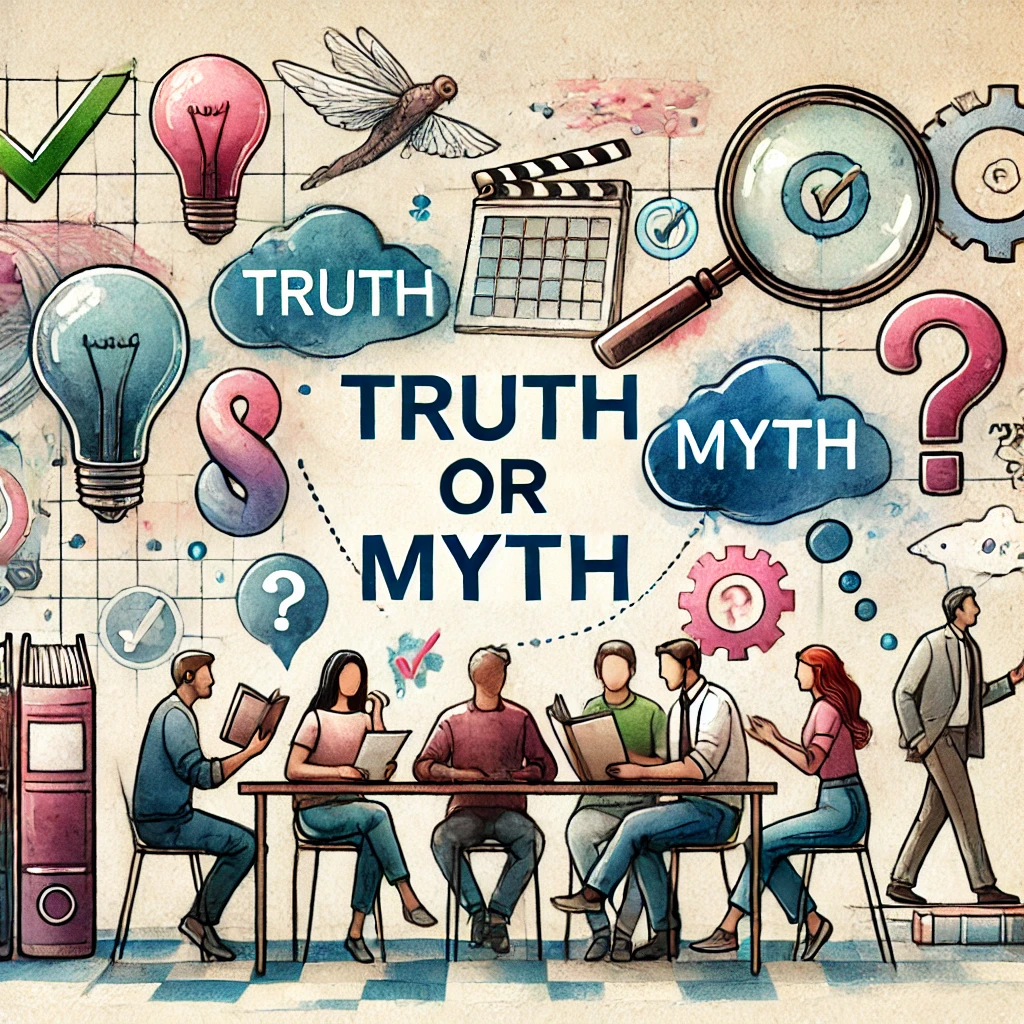ZERO AND FIRST CONDITIONALS

Zero Conditional – The Universal Truth
Learning Objectives: Understand and use the zero conditional for universal truths and habitual actions.
Form (If + present simple, … present simple) and usage for general truths and scientific facts.
Practical Examples:
- “If you heat ice, it melts.”
- “If plants don’t get water, they die.”
First Conditional – The Real Possibility
Learning Objectives: Use the first conditional to talk about real future possibilities.
Form (If + present simple, … will + base verb) for realistic future conditions and their results.
Practical Examples:
- “If it rains tomorrow, we will cancel the picnic.”
- “If I finish my homework, I will watch a movie.”
Learning activities
Conditional Chain Story (First conditional)
Objective:
- Creative Application: Utilize the first conditional structure to creatively contribute to a collaborative story, enhancing understanding and usage of conditional sentences.
- Teamwork and Collaboration: Foster teamwork as students build on each other’s ideas, promoting collaborative storytelling.
- Language Skills Enhancement: Develop students’ grammatical accuracy, creativity, and narrative skills through the use of first conditional sentences in a story context.
Instructions:
- Group Formation and Introduction (5 minutes):
- The class will be divided into small groups of 3-4 students.
- We will briefly review the first conditional structure: If + present simple, will + base form of the verb.
- I’ll explain the the concept of a chain story. Remember, each sentence must use the first conditional to contribute to the narrative.
- Story Starting Point (5 minutes):
- You’ll receive a unique prompt or scenario to start your story, ensuring it can naturally lead to situations requiring the first conditional. You can brainstorm with your group your opening scenario.
- Example prompt: “If it starts to rain during our school trip tomorrow…”
- Writing the Chain Story (20-25 minutes):
- The first student in each group writes the opening sentence based on the prompt, following the first conditional structure.
- The paper or document is then passed to the next student, who reads the story thus far and adds another sentence, also using the first conditional. The process continues, with each group member adding to the story.
- Have a crative and logical progression of the narrative, but remind to focus on using the first conditional accurately.
- Concluding the Story (5 minutes):
- Groups should aim to conclude their story in a creative and satisfying way, ideally also using a first conditional sentence to tie everything together.
- If time allows, groups can discuss and revise their stories for grammatical accuracy and narrative flow.
- Story Sharing and Discussion (15-20 minutes):
- Each group shares their story with the class, highlighting the use of the first conditional in various scenarios.
- We may have a class discussion on the challenges and successes encountered during the activity, focusing on the use of the first conditional in narrative writing.
- Reflection (5 minutes):
- We will conclude with a reflective discussion or a quick write-up on what you learned about the first conditional and storytelling, and how you can apply this understanding in real-world situations.
Example of “Conditional Chain Story”
Group Members: Anna, Ben, Carlos, and Diana
- Anna starts: “If it starts to rain during our school trip tomorrow, we will have to cancel the hiking.”
- Ben adds: “If we cancel the hiking, we might visit the museum instead.”
- Carlos contributes: “If we visit the museum, we’ll learn about the local history and ancient artifacts.”
- Diana continues: “If we learn about the local history, I will write an article for our school newspaper.”
- Back to Anna: “If I write an article for the newspaper, I’ll interview the museum curator to get more insights.”
- Ben follows: “If we get more insights from the curator, our article could win the best school project award.”
- Carlos adds: “If our article wins the award, we’ll be featured in the town’s local newspaper.”
- Diana concludes: “If we’re featured in the town’s local newspaper, it might inspire more students to explore and appreciate our local history.”

Truth or Myth Quiz (Zero Conditional)
Objectives:
- Understand Zero Conditional: Learn to identify and use zero conditional sentences to express universal truths.
- Differentiate Truths from Myths: Develop critical thinking skills by distinguishing between factual statements and myths.
- Enhance Decision-Making Skills: Improve your ability to make informed decisions based on provided statements.
- Practice English Grammar: Apply your knowledge of English grammar in a fun and interactive way.
Instructions:
- Preparation (5 minutes): Before starting the quiz, review the structure and use of zero conditional sentences. Remember, zero conditional is used to express universal truths or scientific facts, using the format “If + present simple, present simple” (e.g., “If you heat water to 100 degrees Celsius, it boils”).
- Quiz Setup (20 minutes): You will receive a list of statements. For each statement, decide whether it is a universal truth (zero conditional) or a myth.
- Responding to Statements: For each statement, write “Truth” if you believe it is a universal truth that can be expressed with zero conditional. Write “Myth” if you think it is a false or exaggerated claim.
- Examples:
- Statement: “If you drop an object, it falls to the ground.”
- Response: Truth
- Statement: “If you eat carrots, you can see in the dark.”
- Response: Myth
- Statement: “If you drop an object, it falls to the ground.”
- Discussion (15 minutes): After completing the quiz, we will discuss each statement as a class. You will explain why you chose “Truth” or “Myth” for each statement and provide the correct zero conditional form for true statements.

Combining Zero and First Conditionals
Gamification with Quizizz (20 minutes)
Objectives:
- Reinforce Understanding: Solidify your grasp of zero and first conditionals through an interactive quiz.
- Apply Grammar Skills: Practice using zero and first conditionals in various contexts.
- Enhance Engagement: Increase motivation and participation through a gamified learning approach.
- Evaluate Knowledge: Assess your knowledge and identify areas for improvement in understanding conditionals.
Instructions:
- Preparation (5 minutes):
- Review: Quickly review the structure and usage of zero and first conditionals:
- Zero Conditional: Used for universal truths and facts (e.g., “If you heat water to 100 degrees Celsius, it boils.”)
- First Conditional: Used for real and possible situations in the future (e.g., “If it rains tomorrow, we will cancel the picnic.”)
- Access Quizizz: Ensure you have access to the Quizizz platform on your device.
- Review: Quickly review the structure and usage of zero and first conditionals:
- Quiz Activity (10 minutes):
- Join the Quiz: Enter the provided Quizizz code to join the quiz.
- Participate: Answer each question carefully, choosing the correct option that best completes the sentence or answers the question related to zero and first conditionals.
- Compete: Enjoy the gamified experience by competing with your classmates in real-time. Try to get as many correct answers as possible to climb the leaderboard.
- Review and Discussion (5 minutes):
- Review Results: Once the quiz is completed, review your results to see which questions you got right and which ones you missed.
- Class Discussion: Discuss some of the trickier questions as a class. Your teacher will provide explanations and clarifications for any common mistakes or challenging questions.
Conditional Debate
Objectives:
- Enhance Grammatical Understanding: Solidify your comprehension and application of zero and first conditionals in constructing logical arguments.
- Promote Critical Thinking: Encourage analytical thinking and the formulation of reasoned arguments supported by conditional sentences.
- Improve Public Speaking Skills: Develop syour confidence and proficiency in articulating their thoughts and arguments in a structured debate format.
- Foster Team Collaboration: Cultivate teamwork and cooperative strategy development as you prepare and present your arguments.
Instructions:
- Preparation:
- Divide the class into teams, assigning each a position on a given topic (for or against).
- Provide a brief review of zero conditional (for general truths or habitual actions) and first conditional (for real future possibilities) constructions.
- Research and Planning (30 minutes):
- Teams research their topic, gathering facts and examples to support their stance.
- Encourage the use of zero and first conditionals in forming arguments (e.g., “If we reduce waste, we will protect the environment”).
- Debate Structure:
- Opening Statement: Each team presents their main arguments (2 minutes per team).
- Argument and Rebuttal Rounds: Teams present detailed arguments and rebut opponents’ points, using conditional sentences to structure their reasoning (3 minutes per argument).
- Closing Statements: Teams summarize their stance and key points (2 minutes per team).
- Debate:
- Conduct the debate according to the structured format, ensuring each team has equal time to present and rebut.

